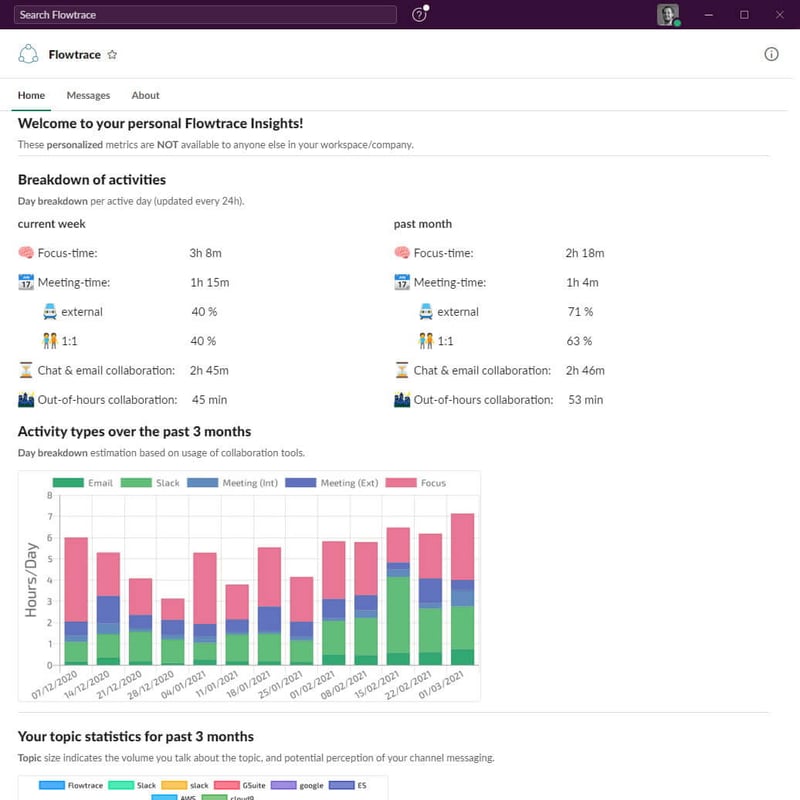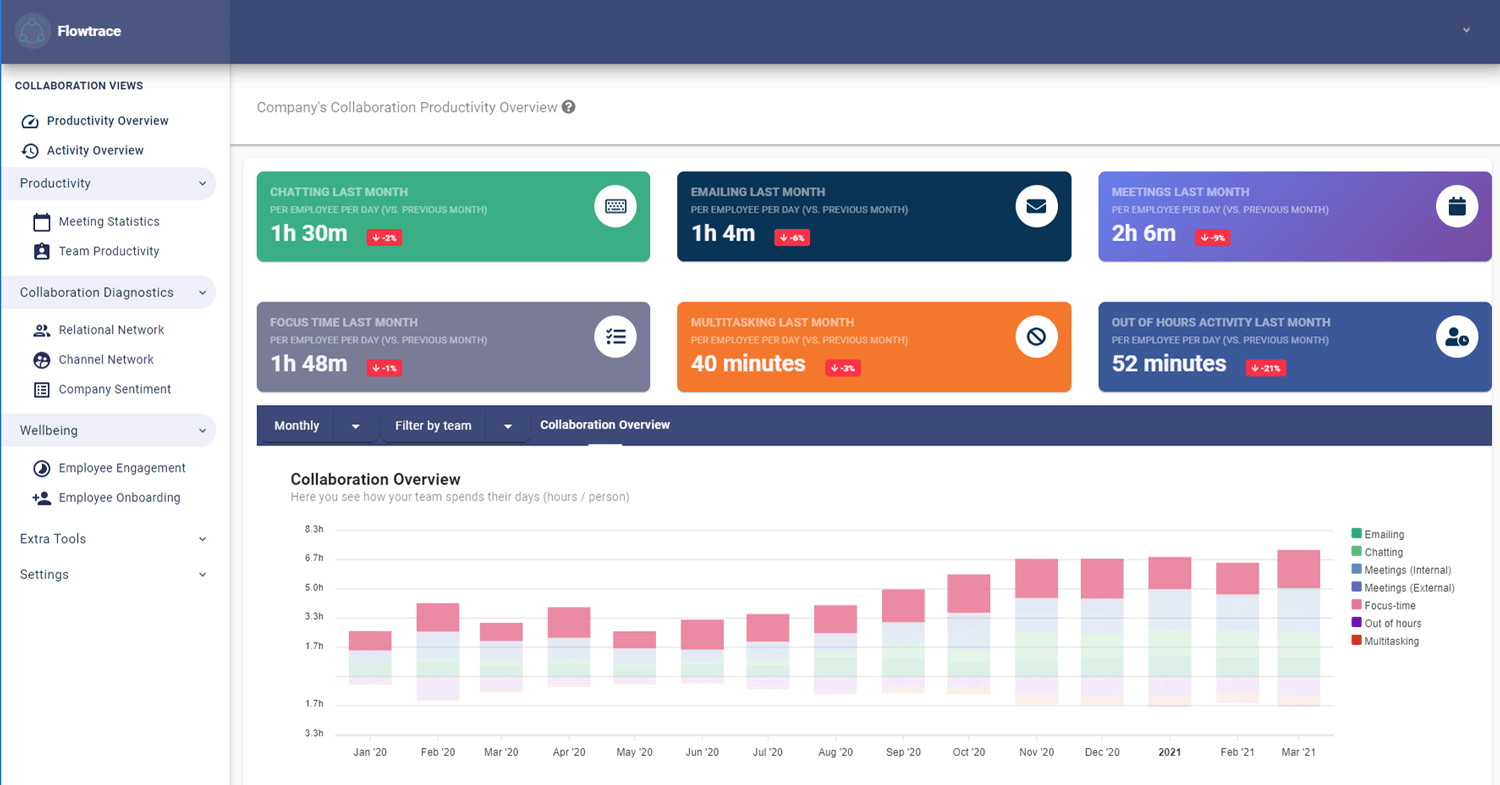Digital notifications and why can't we remove all the distractions?
Multitasking and interruptions are stealing our focus time, and deep work state. Read more about turning off digital notifications and distractions.
Discover the importantce of focus-time, why, and how to get more focus-time! Benefits of focus-time are clear for individual, team, and companies.
Innovation requires our full attention, but in a world riddled with distractions, it's getting increasingly harder to find time to focus. The deep work we do during these focus time moments drives most of the value we are able to generate.
Researchers believe humans can enter deep work for a maximum of four hours per day, while two to three hours of deep work per day is the sweet spot for being able to deliver meaningful projects.
However, the reality of a usual workday can make it difficult to achieve due to:
Read on to discover why it's important for teams to have as much focus time as possible, how you can use Flowtrace as a deep work tracker, and how you can get even more focused as an individual contributor or a leader at your organisation!
In short, focus time (also known as deep work time) is uninterrupted time that allows the individual to use most or all of their potential on a highly demanding task.
In this state, disruptions should be eliminated as much as possible. According to a University of California Irvine study, “it takes an average of 23 minutes and 15 seconds to get back to the task”, meaning that even a quick check for incoming messages can seriously disrupt your flow.
Cal Newport, a renowned author and computer science professor, coined the term “deep work” and describes it as:
“Deep work is the ability to focus without distraction on a cognitively demanding task. It’s a skill that allows you to quickly master complicated information and produce better results in less time.” - Deep Work: Rules for Focused Success in a Distracted World by Cal Newport
When you focus intensely on the work you do, you can increase both - your output and quality. As a result, you can deliver meaningful projects faster and positively contribute to the workplace. However, it's not as easy as it sounds.
If you've ever felt like you did about a million things in a day, but at the end, couldn't exactly recall what you achieved, it's likely you engaged in shallow work which is the opposite of focus time.
So, if you're not keeping an eye on how you spend your time, you could land in the position of keeping yourself busy with small, menial tasks instead of working on high-impact and high-value activities.
Our collaboration analytics tool allows you to track your team's workday and how it's split across the week with these activities:
![]() Snippet from Flowtrace's company productivity overview.
Snippet from Flowtrace's company productivity overview.
To calculate focus time, our AI analyses data from the communication tools you connect (e.g., Slack and Google Workspace), and then measures how much of the workday is spent with minimal interruptions.
You'll see this data in your Collaboration Overview dashboard, and from there, you can look at trends for your whole company or you can drill down to individual teams. You can also select two different time ranges:
You can use Flowtrace as your deep work tracker - a trusty companion for leaders and employees alike in a remote-first world.
If you want to get even better at increasing your productivity and focus time, we recommend these practical resources:
Need a refresher on the importance of focus time? Click here to go up.

Private, personalised metrics report in Flowtrace's app for Slack.
Cal Newport reckons that disorganised employees can do one hour of deep work a day while pros can do four hours, so aiming for two to three hours of deep work per day is a good place to be.
However, it's not as easy to achieve if your workday is full of distractions, starting with work-related noise to notifications on social media networks.
At Flowtrace, we've seen that teams who average two to three focus time hours are more engaged, satisfied, and can deliver meaningful work faster.
If you find that your team's average focus time is one hour or less, it's likely that they are being disrupted too much.
Writing an email or completing a quick admin task may feel satisfying, but it's unlikely to have a major impact on the business. You need to find balance in your workday to do important projects as well as the necessary admin, and above all, prioritise the work that needs to be done to push the needle.
TIP: Our Slack app is the perfect companion to help you find the right balance of focus time, collaboration, and, when absolutely needed, multitasking. All metrics are personalised - only individual users can see this data.
Every task that lands on your project management tool should have a clear description and processes attached. In order to improve productivity and minimise disruptions, explain related goals and KPIs and how each stakeholder fits into the plan. When handing over tasks, make sure the assignee has all of the required information, including expected delivery dates.
Evaluate at what time of day you're most productive and dedicate at least two to three hours of uninterrupted time to work on a single project during this time. It may be first thing in the morning or late in the afternoon - the key is that you do it at a time when you feel the most energetic. Every time you break your flow and switch attention you lose about 25 minutes on average, so try to avoid multitasking at all costs.
Consider introducing Slack office hours to avoid checking messages ad-hoc. Set a time when you deliberately check your communication and collaboration tools. For all other times, either turn off your notifications and mark yourself as Away or switch off the app completely. Of course, you need to communicate this to your team which can be as simple as changing your status update to “Working on project X, back on Slack after lunch”.
It's hard to ask for help when you need it, but if there's a lot on your plate, you need to speak up. Ask your team and see if anyone has free time to learn something new and help you with the project.
Need a refresher on the importance of focus time? Click here to go up.
 See how your team spends their days in our Collaboration Overview.
See how your team spends their days in our Collaboration Overview.
It's widely believed that reaching two to three hours of focus time every day is what's needed to complete meaningful projects and drive the company forward in an impactful way.
If your teams are struggling to focus, you'll first need to better understand how their workdays are structured and what may be blocking them from doing their best work.
Your teams need to understand how to work with each other and more precisely, how high-value work is delivered. This is especially important for teams where the flow state of work differs. For example, customer support is mostly reactive and short-term while engineering is proactive and long-term. The way high value is delivered in these constraints differ and must be accounted for.
See how project planning can be improved across the organisation and make sure that work is prioritised fairly. Avoid pushing work onto others and allow teams to pull in new work when they're ready and have completed the previous task to reduce the number of half-baked projects. Encourage teams to think about shared goals and the impact of the projects they put forward.
Make work more visible and set the right expectations by categorising projects as planned work, unplanned work, customer work, internal work, or improvement work. Encourage teams to always set clear and manageable expectations.
Respect the focus time of others and avoid accidental slip-ups of focus across the board. Emphasise how it's acceptable to decline meetings (even leadership invites), during recurring, agreed-on focus hours. Align these across teams and departments to avoid unnecessary scheduling issues for meetings.
Allow each team to share how they manage their projects. If possible, ask them to document their workflow, complete with details on ownership and maintenance. Teams should clearly highlight their stakeholders, the process for handovers, and capacity for unplanned work. Keep in mind the 80/20 rule when defining these processes. Defining 100% of all the work items can make your organisation too rigid and slow to adapt.
There are multiple techniques of how you can increase focus time (as well as productivity and the quality of your work).
Our company analytics tool, Flowtrace, can help you understand how you spend your time so you can make smarter decisions in the future, as an individual contributor or leader at your organisation.
For more advice on how to act on the data you see in Flowtrace, sign up for our newsletter and be the first to read the next articles in our blog series.
Multitasking and interruptions are stealing our focus time, and deep work state. Read more about turning off digital notifications and distractions.
Learn what is the difference between deep work and shallow work and create your own deep work routine by minimizing shallow work and distractions.
We reveal the importance of focus in the workplace and provide insights into the consequences of employees struggling to focus.